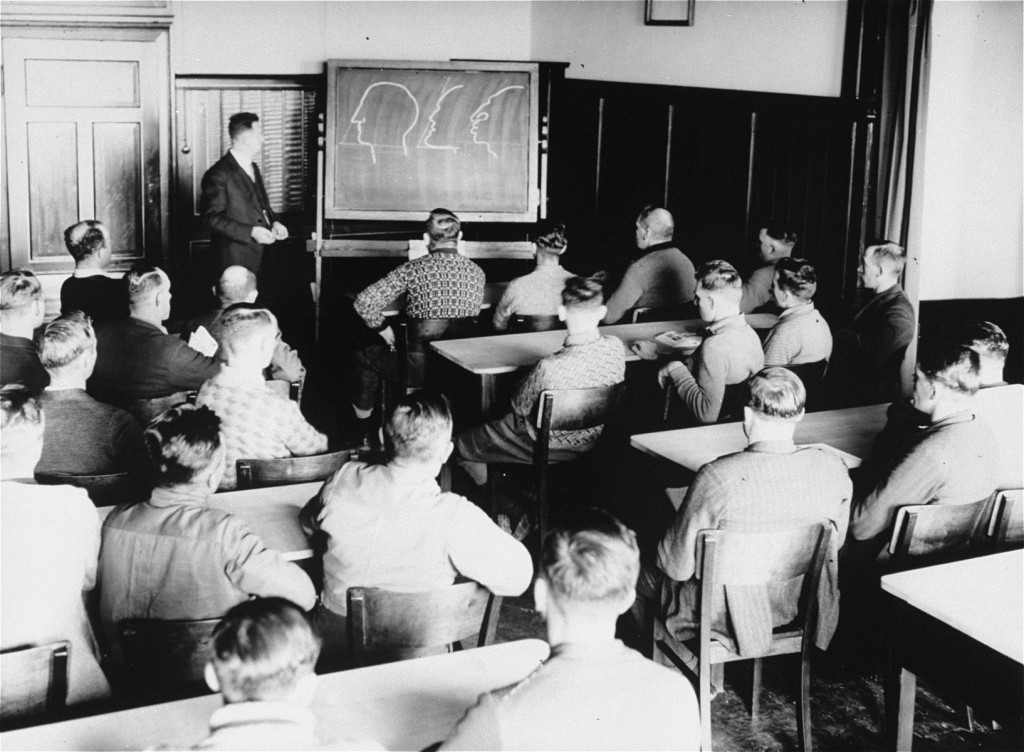
Nazi Racism: In Depth
The doctrine of racism asserts that blood is the marker of national-ethnic identity. It assumes that inherited characteristics biologically determine human behavior. With respect to the ultimate value of a human being, racists place a higher value on membership in a “race” than on individuality. Racists define national-ethnic identity through the myth of “pure inherited blood. ” In practice, however, they can only point to differences in visible but biologically superficial characteristics such as skin, hair, and eye color.
Nazi racism would produce murder on an unprecedented scale.
Pseudoscientific Basis
Racists believe that innate, inherited characteristics biologically determine human behavior. In the early twentieth-century, such views on race were widely accepted in many parts of the world. In fact, race is not biologically based, it is a cultural classification of groups.
Many intellectuals, including scientists and historians, have lent pseudoscientific support to racist thinking. In continental Europe, particularly in Germany and German-speaking Austria, nineteenth century racists saw the highest human value as membership in a “collective racial nation.” Nineteenth century racist thinkers, such as Houston Stewart Chamberlain and Guido von List as well as racist politicians like Georg von Schönerer exerted a significant influence on many in the generation of Adolf Hitler.
Racism in National Socialism
Racism, including racial antisemitism, was always an integral part of German National Socialism. The Nazis perceived all of human history as the history of a biologically determined struggle between races. They postulated that political movements such as Marxism, communism, pacifism, and internationalism were anti-nationalist and reflected a dangerous, racially based Jewish intellectualism.
In 1931, the SS established a Race and Settlement Main Office (RuSHA) to
- conduct race "research"
- determine the racial suitability of prospective candidates for SS membership
- determine the racial suitability of potential spouses for SS members.

During the war, RuSHA experts made pseudo-scientific determinations of who was German and who had the “racial potential” to be German. Such determinations could mean the difference between life and death, as in cases in which a pregnancy resulted from a sexual relationship between a Polish forced laborer in Germany and a German woman. If deemed by the “race examiner” to be a Pole incapable of “Germanization,” the Polish father was likely to be hanged.
The "Biologically Inferior"
Two years after the Nazis came to power, the German government decreed the Nuremberg Race Laws in 1935. These laws codified a supposedly biological definition of Jewishness.

The Nazi leadership considered the so-called Jewish race to be not only the most inferior of “races,” but the most dangerous, since the Nazis attributed to the Jews inherited talent to mobilize the inferior, but more numerous “races” against the so-called superior races in a titanic biological struggle. Having “defined” Jewishness, the Nazis implemented a policy aimed at the physical elimination of the European Jews during World War II.
Nazi racists had always viewed the people with mental and physical disabilities as blemishes upon the genetic landscape of the so-called master race and, insofar as they were capable of conceiving children, as a biological danger to the purity of the German Aryan “race.” After careful planning and data collection during the summer and autumn of 1939, German physicians murdered people with mental and physical disabilities or illnesses who resided in institutions throughout Germany. The Nazi leadership and the German health care community euphemistically referred to the series of operations aimed at the physical annihilation of the so-called unfit as "euthanasia".

During the war, German physicians conducted bogus medical experiments seeking to identify physical evidence of German Aryan racial superiority to other so-called races. Despite killing countless prisoners in the course of these experiments, they could not find a scientific basis for their racial theories. Indeed, despite attempts of racists for two hundred years to discover "scientific" evidence of inherited inferiority of certain so-called races, biological science does not support the racist notion of racial differences between different groups of human beings that go beyond superficial external physical characteristics, such as skin or eye color. Moreover, there is no scientific basis for the notion that possession of a certain skin or eye color denotes superior or inferior physical or mental health or abilities or inherited personality traits.
The Nazi regime targeted Roma (Gypsies) as “racially inferior” and sufficiently “dangerous” to warrant elimination through mass murder. During twelve years of Nazi rule German Roma were incarcerated in prisons, labor camps and concentration camps. During World War II, the Germans, consistent with Nazi racial policy, shot Roma and deported them to killing centers.
Also included among the so-called inferior races in Nazi ideology were the Slavic peoples of Eastern Europe and the Asian ethnic groups of the Soviet Union. During World War II, the Nazi leadership set about what they referred to as an "ethnic housecleaning" in occupied Poland and the Soviet Union. This policy included the murder and annihilation of enemy "races." The Germans carried out systematic mass killings of persons considered to be members of Polish and Soviet political, cultural, and intellectual elites, and systematically selected from among captured Soviet prisoners of war persons perceived to have “Asian” or “Mongolian” characteristics in order to shoot them.
The Nazis also perceived German residents of African nationality or descent as inferior and dangerous and planned for their eventual disappearance—within a generation—through a mass sterilization policy. Though this policy was not consistently applied, the German authorities routinely and viciously persecuted and discriminated against German residents of African descent.
Consequences of Nazi Racism
From their racism, the Nazis concluded that “inferior peoples” had to either be physically eliminated completely or intellectually decapitated. Physical elimination was to take place immediately by mass murder or within a generation by sterilization. These policies of elimination were applied toward Jews, Roma, persons with disabilities living in institutions, and German residents of African descent. Intellectual decapitation was to be achieved through mass murder of the leadership elites and reduction of the surviving population into a reservoir of uneducated forced manual laborers.
Critical Thinking Questions
How can knowledge of the events in Germany and Europe before the Nazis came to power help citizens today respond to threats of genocide and mass atrocity in the world?
How can individuals and leaders recognize and respond to indications that a country is at risk for genocide or mass atrocity?
Despite overwhelming scientific data to the contrary, many people still believe in the superiority of certain races. Why might individuals hold onto a belief that has been discredited?
How can societies, communities, and individuals reinforce and strengthen the willingness to stand up for others?

